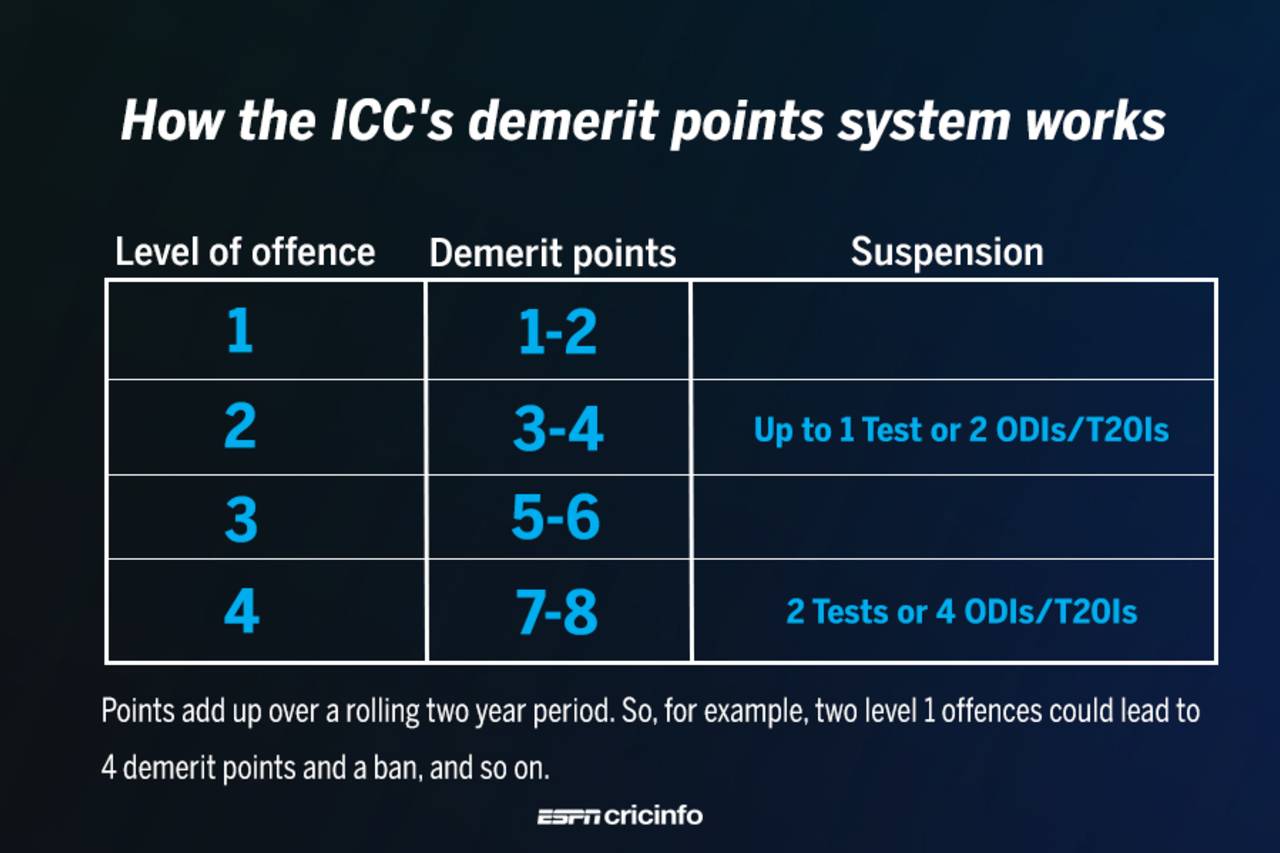An explainer of ICC's demerit points system
Ravindra Jadeja's one-Test ban is the latest in a series of suspensions under the demerit points system that was introduced in 2016
ESPNcricinfo staff
09-Aug-2017

Ravindra Jadeja's six demerit points will see him sit out the Pallekele Test • ESPNcricinfo Ltd
Why has Ravindra Jadeja been banned for India's third Test in Sri Lanka?
Jadeja has accumulated six demerit points in the past 10 months as per the ICC's Code of Conduct regulations. Four demerit points within 24 months leads to a one Test or two limited-over games suspension.
Jadeja has accumulated six demerit points in the past 10 months as per the ICC's Code of Conduct regulations. Four demerit points within 24 months leads to a one Test or two limited-over games suspension.
During the second Test, Jadeja, after bowling to Malinda Pushpakumara, threw the ball at the batsman. It was deemed "dangerous" by the umpires, and he was given three demerit points. Jadeja already had three demerit points for running on the pitch during the home Test series against England last October.
So how does this demerit point system work?
The idea behind the demerit points system is to punish players for repeatedly breaking the Code of Conduct. The Code of Conduct describes four different levels of offences, each of which have a certain number of demerit points assigned to them. Jadeja's offence was categorised Level 2, which results in three or four demerit points, depending on the nature of the breach. Once a player is given demerit points, they stay on his record for 24 months. So any other demerits he gets are added to them.
If a player gets four demerit points within 24 months, he gets a one Test or two-limited over game ban. If he gets eight demerit points within 24 months, the ban doubles.
Who decides what level of offence has been committed and how many demerit points a player should receive?
In most cases, it is the on-field umpires who report offences to the match referee. He then decides on the number of demerit points and informs the player or team of his decision. The player and team can then contest it, which would lead to a hearing.
In most cases, it is the on-field umpires who report offences to the match referee. He then decides on the number of demerit points and informs the player or team of his decision. The player and team can then contest it, which would lead to a hearing.
So now that Jadeja has been banned, will his demerit points be reset to zero?
No. He will continue to have six demerit points till October 2018, when the three points he got for running on the pitch will finally be removed. So till then, he has to be careful. Two more demerit points will mean a two-Test or four limited-over game suspension. Even after October 2018, the three demerit points he got in this series will still stand till 24 months from now, so if he gets a single demerit point between October 2018 and August 2019, he'll get another one Test/two limited-overs game suspension.
But isn't that punishing a player twice for the same offence?
It seems that way, but the point of the demerit point system is to increase the level of punishment the more frequently a player breaches the Code of Conduct. Also, having the demerit points still stand after a suspension will prevent players from deliberately committing offences in order to time their bans so they miss less important matches.
If Jadeja knew another demerit point would get him suspended for a Test but then clear his record, he could have deliberately got one so he missed the dead rubber against Sri Lanka and went into the next series with a clean slate. But this way, his six demerit points stay with him despite the suspension.
How long has this system been around for? And how is it different from the previous one?
The demerit points system was introduced by the ICC in September 2016. The Code of Conduct has been in place for a long time, but earlier Level 1 and Level 2 offences resulted only in fines. Now, an accumulation of minor offences could lead to suspensions.
How many cricketers have accumulated these points so far?
A total of 45 male and seven female players across Full Members and Associates have been handed demerit points in the 11-month period since the new rules came in. Only two of them - Niroshan Dickwella (7) and Ravindra Jadeja (6) - have six or more points.
A total of 45 male and seven female players across Full Members and Associates have been handed demerit points in the 11-month period since the new rules came in. Only two of them - Niroshan Dickwella (7) and Ravindra Jadeja (6) - have six or more points.
A list of all players carrying demerit points is available on the ICC's website.
Will the introduction of yellow and red cards affect the demerit point system?
From October 1 onwards, umpires will be empowered to penalise players and teams during games, instead of just sanctioning and punishing them at the end of it. They will be able to give teams run penalties and even, in extreme scenarios, remove players from the field.
From October 1 onwards, umpires will be empowered to penalise players and teams during games, instead of just sanctioning and punishing them at the end of it. They will be able to give teams run penalties and even, in extreme scenarios, remove players from the field.
These new rules are thought to be mainly aimed at protecting umpires in lower-level cricket. The demerit points system will remain the same as it is aimed at taking action against players after games.